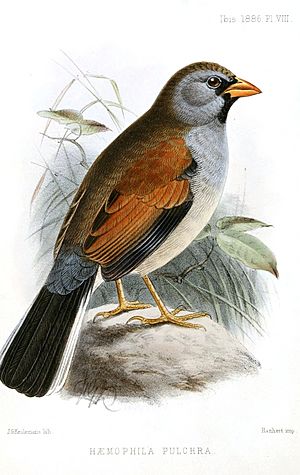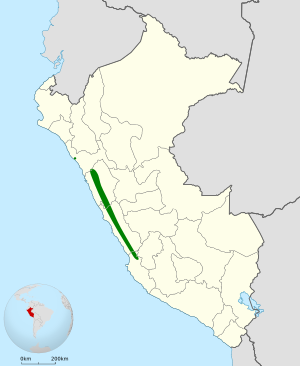Great Inca finch facts for kids
Quick facts for kids Great Inca finch |
|
|---|---|
 |
|
| Conservation status | |
| Scientific classification | |
| Genus: |
Incaspiza
|
| Species: |
pulchra
|
 |
|
| Synonyms | |
|
Haemophila pulchra (protonym) |
|
The great Inca finch (scientific name: Incaspiza pulchra) is a small, colorful bird that lives only in Peru. It's a type of passerine bird, which means it's a "perching bird" – like most songbirds you see. This special bird belongs to the tanager family, called Thraupidae. Before, scientists thought it was part of the Emberizidae family, which includes buntings and sparrows.
This unique bird is found only in Peru, making it an endemic species. This means you won't find it naturally anywhere else in the world!
Contents
About the Great Inca Finch
The great Inca finch is known for its pretty colors and its home in the high mountains. It was first described by a scientist named Philip Sclater in 1886.
What Does it Look Like?
The great Inca finch is a medium-sized finch. It has a strong beak, perfect for eating seeds. Its feathers are a mix of colors, often with shades of yellow, brown, and black. These colors help it blend in with its mountain home.
Where Does it Live?
The great Inca finch lives in the Andes Mountains of Peru. Its natural habitat is high up in the mountains, usually in subtropical or tropical shrubland. This means it likes areas with lots of bushes and small trees, often found at high altitudes. These places can be quite cool and misty.
High-Altitude Shrubland
High-altitude shrubland is a special type of environment. It has plants that are tough enough to survive strong winds and cold temperatures. These areas provide food and shelter for the great Inca finch. The birds find insects, seeds, and berries among the bushes.
What Does it Eat?
Like most finches, the great Inca finch mainly eats seeds. Its strong beak helps it crack open tough seeds. It might also eat small insects, especially when feeding its young.
Conservation Status
The great Inca finch is currently listed as "Least Concern" (LC) by the International Union for Conservation of Nature (IUCN). This means that its population is stable, and it is not currently facing a high risk of extinction. However, it's always important to protect their natural habitat to keep them safe for the future.
See also
 In Spanish: Incaspiza alirrufo para niños
In Spanish: Incaspiza alirrufo para niños



